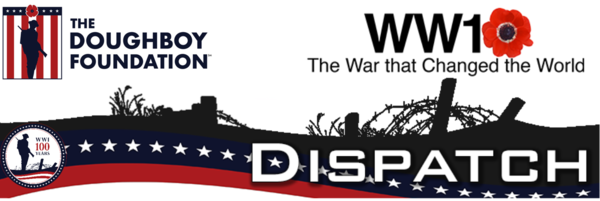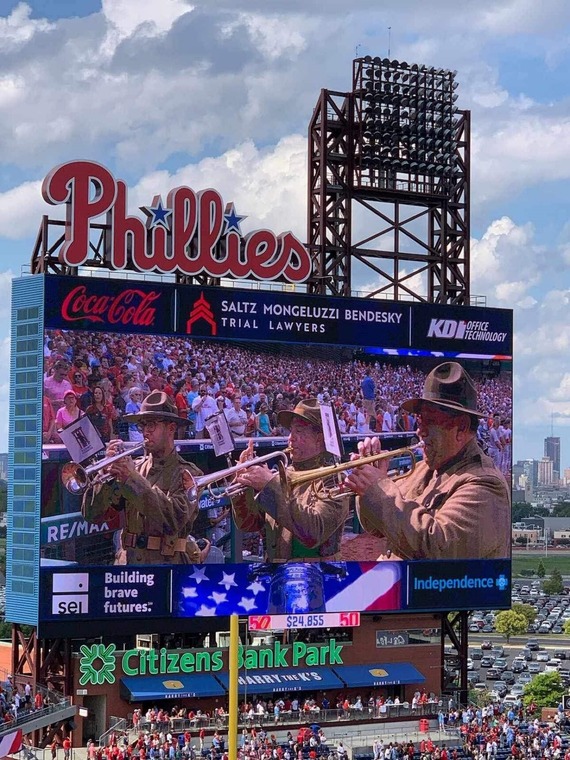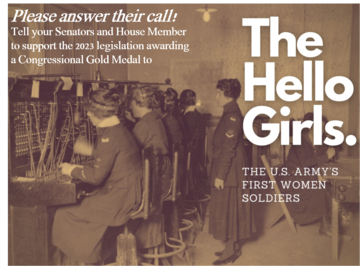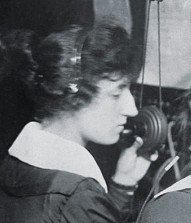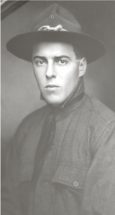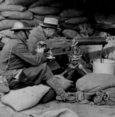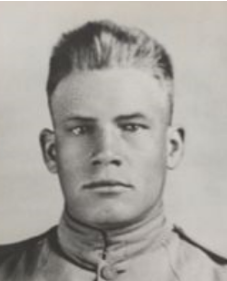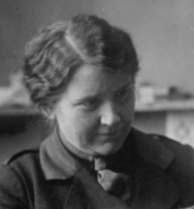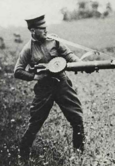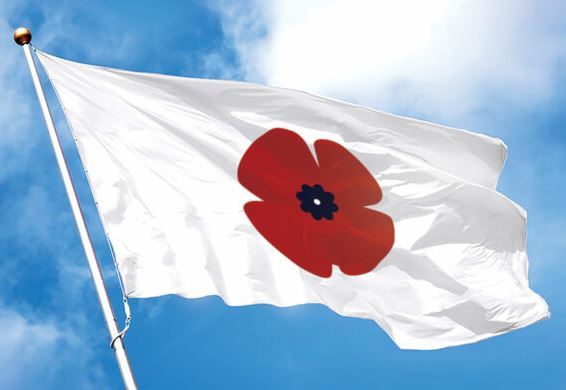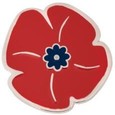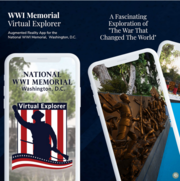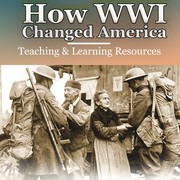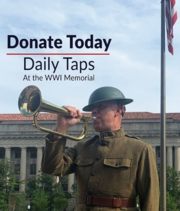Sandra Pershing, Nov. 11, 1941–Aug. 14, 2023

Sandra Sinclair Pershing passed away on August 14, 2023 at her home in Quogue, NY, surrounded by her family. She was a Member of the Board of Directors of the Doughboy Foundation, and a Special Advisor to the U.S. World War I Centennial Commission. Sandra Pershing was the granddaughter-in-law of General of the Armies John J. Pershing, the Commander of The American Expeditionary Forces in World War I. She was a philanthropist, a filmmaker, and a charitable volunteer. Sandra Pershing played an important role in encouraging the construction of the National World War I Memorial in Washington, DC. Click here to read more about Sandra Pershing, and how she dedicated herself to keeping the memory of America's Doughboys alive in our nation.
|

Congress Needs To Hear From You
About The Hello Girls Gold Medal
|
Congress will be getting back from their recess after Labor Day, and will pretty quickly get involved in headline issues like keeping the government open, and passing a budget, and so forth. But you still have a short window available to reach out to your Senators and Representatives before they get too busy, and let them know that you support the Congressional Gold Medal legislation introduced in both the Senate and House to honor the brave American women who made critical tactical communications work for U.S. and French military forces on the front lines of World War I, but who were denied veterans status and benefits from after WWI ended until 1977.
|
|
 |
Click here for our toolbox that makes the process of reaching out to your Representative and Senators very straightforward. Please get in touch with your Senators and Representative before or after after Labor Day, and tell them that you want them to support the Hello Girls Congressional Gold Medal legislation in the 118th Congress. When their nation called in 1918, the Hello Girls answered -- please answer their call in 2023!
During the week of August 13, Daily Taps at the National World War I Memorial in Washington, DC was sounded in honor of WWI veteran Pvt. William B. Wilson, namesake of Beacon, NY VFW post No. 666.
|
Private William B. Wilson was killed in action in Belgium on August 19, 1918, the first soldier from Beacon, NY to die in WWI. Wilson went off to war with two of his best friends, George Van Pelt of Beacon and Herbert Miller of Newburgh, NY. On the day of August 19, Company L was under continuous shelling by the Germans, resulting in several American casualties. One of those was Herb Miller, who lay in No-Man’s Land, too dangerous to be retrieved in daylight. The night of August 19, Private Wilson and Corporal Richard Connery volunteered to go out and bring Miller back to the American trenches. Both men carried Miller on a stretcher under a heavy barrage of mortar fire. Connery was wounded by shrapnel; Wilson was killed by a sniper. In 1922, Beacon veterans would form a new VFW post and call it the Private William B. Wilson Post 666.
|
|
 |
The Daily Taps program of the Doughboy Foundation provides a unique opportunity to dedicate a livestreamed sounding of Taps in honor of a special person of your choice while supporting the important work of the Doughboy Foundation. Choose a day, or even establish this honor in perpetuity. Click here for more information on how to honor a loved veteran with the sounding of Taps.

Bennington College student Cianna Lee took a summer job at an auction house, and spent her time researching and pricing books for an upcoming auction. Going through "a big tub of random books" from the auctioneer's backlog, she "spotted this diary almost immediately. Turning the pages, I realized the diary was about World War I and was written from the war front in 1918... Remarkably, I realized that the owner had not written his name anywhere on it." Thus began Cianna's quest to identify the author of the remarkable diary that documented, from a soldier's point of view, important WWI accomplishments in American military medicine. Click here to follow the search process with her, and find out how the author was finally identified, and a forgotten soldier is now remembered once more.
|

Real aviation history will take to the skies each day with flying demonstrations combined with presentations by historians, restorers, and authors for featured aircraft. In addition to the flying displays, WWI re-enactors and a WWI M1917 tank will also be present and will participate in combat presentations each day. There will also be exhibitions of original rare WWI uniforms and flight clothing of noted World War I aviators such as Douglas Campbell, America’s First Ace; and the original leather flight coat of Captain Eddie Rickenbacker. Click here to read more, and find out how you can attend this exciting event and see World War I aircraft and tanks in action!

The arrival of a new plane at Selfridge Military Air Museum in Harrison Township is always exciting news no matter how many times it happens. The newest arrival is Jenny, a World War I bi-plane known as a Curtiss JN-4, which was purchased by FreeStar Financial Credit Union and is being gifted to the museum. “There are currently only seven Jenny aircraft left in the world and now our museum will have one of them,” Ed Kaminski, deputy director of the museum said, in a news release. Click here to read more, and learn how Curtiss JN-4 aircraft were used to train pilots at Selfridge Field in 1917
|

Nearly eight months to the day after Armistice had been declared, Fayette County, Ohio lost its last son in World War I. Seaman Second Class Homer Perdue drowned on July 12, 1919, in the sinking of the USS Richard Bulkeley. When the U.S. entered World War I, Homer wanted to serve his country. Unfortunately, he was 37 years old; at that time, he was too old to enlist. The Selective Service Act was amended in August 1918 and expanded to cover men between the ages of 18 – 45. That same month Homer Perdue enlisted in the US Navy. Click here to read the whole story about Homer's patriotic service, and how the perils of WWI extended beyond the armistice that ended the fighting.
|

Eliza Scidmore, an American journalist and travel writer, was in Yokohama in the summer of 1914 when World War I broke out. In late August, Japan became a partner of Great Britain and the Allies to help rout German battleships from Pacific waters. Scidmore hustled to write about the developments for The Outlook, an American magazine. This big news was just the latest chapter in Scidmore's reporting about Japan to Americans, helping them understand what was still a mysterious but growing power in Asia. However, despite a long and productive writing career, her most visible legacy in America is one that entrances Washington, DC and the nation every spring. Click here to read how author Diana Parsell discovered that Scidmore was the earliest champion of planting Japanese cherry blossoms in Washington, D.C.
|

For years, Mark Weber listened as his family shared vague retellings of his great uncle Henry Weber's combat experiences, never able to verify the accuracy of the astonishing accounts. But once he started researching the World War I service of Henry Weber, who was inducted into the U.S. Army on Sept. 20, 1917, and sent to Camp Funston, Kansas, for training, the story got even more remarkable. Click here to read the entire account of Henry Weber's World War I service with the "Rock of the Marne" division, and learn how Weber was seriously wounded on July 28, 1918, and "laid in a trench for three days before he was found by someone."
|

During World War I, Anna Coleman Ladd moved to Paris and made masks for men whose physical identities had been ripped apart by the conflict. Thanks to her artistic talents, around 100 disfigured veterans were given a new lease on life. A renowned artist in her time, the American sculptor exhibited her Neoclassical works in Washington D.C., Philadelphia, and New York City. Yet gallerists were never interested in the most moving aspect of her work: prosthetics she created during an 11-month stay in Paris to help mutilated soldiers returning from World War I. Click here to read the whole story, and learn how Ladd's dedication earned her France's Légion d’Honneur long after the war was over.
|

Travis Pike, writing on the Gat Daily web site, has a question: "Imagine you’re a twenty to-year-old 2nd L.T. in the U.S. Army. You joined the American Expeditionary Force in Europe in 1917. The Great War is raging on. You have an infantry platoon to lead, so what weapons have the Army issued you?" There is an easy answer, Pike says: "You’re clearly armed with a Springfield M1903 and an M1911, right? Maybe, but in reality, the armament of the American Doughboy was not toting M103s and M1911s into combat." Click here to read the entire article, and learn how, during America's scramble to outfit an army in 1917-18, there simply weren’t enough M1903 and M1911s to go around, so the U.S. Army had to use several alternatives to properly equip the Doughboys for combat.
|

Homer Armstrong was a farm boy who lived with his aunt and uncle, Mr. and Mrs. Alex J. Brown, west of Philomath, Oregon in 1917 when the U.S. entered WWI. On July 31, 1918, he was killed in action north of the village of Cierges in France. As reported by Doughboy MIA, "His comrades buried him in a hasty battlefield grave that day, the position of which was reported to Graves Registration Service. Nevertheless, when GRS officials went looking for the grave after the war, it could not be located. “Homer remains missing to this day and is memorialized on the Walls of the Missing at the Aisne-Marne American Cemetery at Belleau, France.” Click here to read more about Homer, and learn how his service was recently honored by the Doughboy Foundation during Daily Taps on July 31 — 105 years to the day after he was killed in action.
|
 |
|
World War I was The War that Changed the World, and its impact on the United States continues to be felt over a century later, as people across the nation learn more about and remember those who served in the Great War. Here's a collection of news items from the last month related to World War I and America.
|
How America Nearly Forged A Different Path In 1916
World War I: Wednesday: Ice Cream And Hospital Ships
How The Start Of WWI Changed An American Heiress’s Life
Has U.S. Ever Fought On Russian Soil? You’d Be Surprised.
Five Of America’s Best World War I Recruitment Posters
Brotherhood, Poetry, And Mental Illness During World War I
Unpacking Stories Behind Artist’s Portrayal of Harlem Hellfighters
Why U.S. Broke Diplomatic Relations With Germany In 1917

A man is only missing if he is forgotten.
Our Doughboy MIA this month is First Lieutenant Sidney Paul Thompson of the 95th Aero Squadron.
Awarded France’s Croix de Guerre with Palm Shot for his actions on 5 July 1918 while flying only his third mission of the war on July 5th, 1918, our Doughboy MIA of the month is First Lieutenant Sidney Paul Thompson of the 95th Aero Squadron. Since he had such a short combat history, little is known about Lieutenant Thompson. Very few of his squadron mates mention him in their memoirs and letters, but this is what we do know of this brave flyer.
Sidney Paul Thompson was born the third child to Frederick C Thompson, a carpenter, and Mary V. Westervelt Thompson, on 23 January 1895 in Jacksonville, New York. His mother can trace her Westervelt family roots over 200 years to Epke Jacobse, an early Dutch settler of New Amsterdam, now Manhattan, New York, who came to North America from Holland in 1659. Frederick and Mary would move to Ithaca, New York after their marriage in 1880 and would give birth to a daughter Mildred in 1883 and then two boys, Harold in 1893 and Sidney in 1895. There Frederick would join the Rescue Steamer Company 2 of the Ithaca Volunteer Fire Department and work in his carpentry trade.
Sidney graduated from Ithaca High School in 1913. Though the school was destroyed by fire on 14 February 1912, in Sidney’s junior year, he still managed to finish on time to begin attending Cornell University in its Architecture program. After the United States joined the war Sidney Thompson, while a junior at Cornell, most certainly was one of the many students and faculty members who signed a petition requesting the U.S. War Department establish an aviation ground school at Cornell. This petition was approved creating the U.S. Army School of Military Aeronautics at Cornell University.
Would you like to be involved with solving the case of First Lieutenant Sidney Paul Thompson, and all the other Americans still in MIA status from WWI? You can! Click here to make a tax-deductible donation to our non-profit organization today, and help us bring them home! Doughboy MIA will be mounting another mission to France this summer. Help us do the best job possible and give today, with our thanks.
|
Merchandise from the Official
Doughboy Foundation WWI Store

- A Doughboy.shop Exclusive
- Premium, Dual sided Poppy Design
- 5’ x 7’ Digital Nylon
- Grommets for rigging
- Limited Edition
- Made in USA
|
